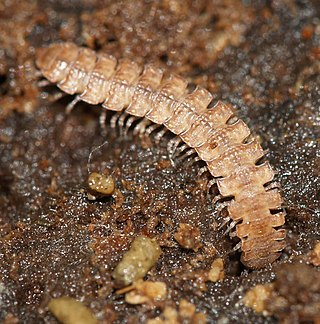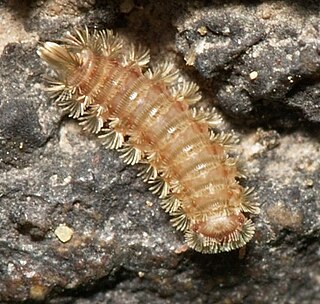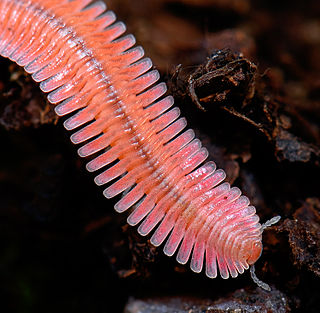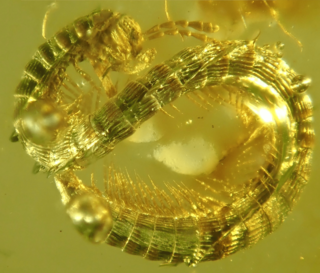
Millipedes are a group of arthropods that are characterised by having two pairs of jointed legs on most body segments; they are known scientifically as the class Diplopoda, the name derived from this feature. Each double-legged segment is a result of two single segments fused together. Most millipedes have very elongated cylindrical or flattened bodies with more than 20 segments, while pill millipedes are shorter and can roll into a tight ball. Although the name "millipede" derives from Latin for "thousand feet", no species was known to have 1,000 or more until the discovery in 2020 of Eumillipes persephone, which can have over 1,300 legs. There are approximately 12,000 named species classified into 16 orders and around 140 families, making Diplopoda the largest class of myriapods, an arthropod group which also includes centipedes and other multi-legged creatures.

Chilognatha is a subclass of the class Diplopoda, which includes the vast majority of extant millipedes, about 12,000 species.

Myxophaga is the second-smallest suborder of the Coleoptera after Archostemata, consisting of roughly 65 species of small to minute beetles in four families. The members of this suborder are aquatic and semiaquatic, and feed on algae.

The Stephanidae, sometimes called crown wasps, are a family of parasitoid wasps. They are the only living members of the superfamily Stephanoidea. Stephanidae has at least 345 living species in 11 genera. The family is considered cosmopolitan in distribution, with the highest species concentrations in subtropical and moderate climate zones. Stephanidae also contain four extinct genera described from both compression fossils and inclusions in amber.

Glomerida is an order of pill-millipedes found primarily in the Northern Hemisphere. Also known as northern pill millipedes, they superficially resemble pill-bugs or woodlice, and can enroll into a protective ball. They have twelve body segments, 17 to 19 pairs of legs, and males have enlarged rear legs involved in mating. The order includes about 30 genera and at least 280 species, including Glomeris marginata, the common European pill-millipede. The order contains members in Europe, South-east Asia and the Americas from California to Guatemala. Although historically considered closely related with the similar sphaerotheriidans that also enroll, some DNA evidence suggest they may be more closely related to glomeridesmidans, a poorly known order that does not enroll.

Polyxenida is an order of millipedes readily distinguished by a unique body plan consisting of a soft, non-calcified body ornamented with tufts of bristles – traits that have inspired the common names "bristly millipedes" or "pincushion millipedes". There are at least 86 species in four families worldwide, and are the only living members of the subclass Penicillata.

Platydesmida is an order of millipedes containing two families and over 60 species. Some species practice paternal care, in which males guard the eggs.

Siphonophorida is an order of millipedes containing two families and over 100 species.

Xyloiuloidea is an extinct superfamily of millipedes that existed from the Lower Devonian through the Upper Pennsylvanian period in Europe and North America.

Callipodida is an order of millipedes containing around 130 species, many characterized by crests or ridges.

Chordeumatida is a large order of millipedes containing some 1200 species with a nearly worldwide distribution. Also known as sausage millipedes, they grow and develop through a series of moults, adding segments until they reach a fixed number in the adult stage, which is usually the same for a given sex in a given species, at which point the moulting and the addition of segments and legs stop. This mode of development, known as teloanamorphosis, distinguishes this order from most other orders of millipedes, which usually continue to moult as adults, developing through either euanamorphosis or hemianamorphosis.

Siphoniulus is a poorly known genus of millipede containing only two living species: S. alba from Indonesia, and S. neotropicus from Mexico and Guatemala. An additional two fossil species are known from Cretaceous amber. Siphoniulus species are the only members of the family Siphoniulidae and order Siphoniulida, making Siphoniulida the smallest millipede order. Few specimens are known, and their classification is contentious, although most recent studies place them as basal members of the Helminthomorpha.

Stemmiulida is an order of millipedes consisting of approximately 130 species, reaching up to 50 mm in length. It contains a single family, Stemmiulidae.

Juliformia is a taxonomic superorder of millipedes containing three living orders: Julida, Spirobolida, and Spirostreptida, and the extinct group Xyloiuloidea known only from fossils.

Cambalidae is a family of millipedes in the order Spirostreptida. There are at least 20 genera and 80 described species in Cambalidae.
Glyphiulus, is a genus of millipedes belonging to the order Spirostreptida, family Cambalopsidae. It is the largest Southeast Asian millipede genus comprise about 47 to 57 species ranging from southern China, northern Laos, and northern Thailand in the north to southern Vietnam in the south. The type species shows a pantropical distribution. The number of species always changes due to continuous discoveries of new species.
Burmese amber is fossil resin dating to the early Late Cretaceous Cenomanian age recovered from deposits in the Hukawng Valley of northern Myanmar. It is known for being one of the most diverse Cretaceous age amber paleobiotas, containing rich arthropod fossils, along with uncommon vertebrate fossils and even rare marine inclusions. A mostly complete list of all taxa described up until 2018 can be found in Ross 2018; its supplement Ross 2019b covers most of 2019.

Burmanopetalum is an extinct genus of millipede containing the single species Burmanopetalum inexpectatum from the Cretaceous of Myanmar. It is a member of the order Callipodida and is the only member of the suborder Burmanopetalidea and family Burmanopetalidae.

Bukhkalius is an extinct genus of beetle belonging to the family Ommatidae, it contains the single species, Bukhkalius lindae. It was described in 2017 initially as a species of the extant genus Tetraphalerus and was placed into a separate monotypic genus in 2020, which was reaffirmed in a 2021 study. It is known from a single specimen from Burmese amber, dating to the Cenomanian stage of the Late Cretaceous. The specimen is around 4.7 mm long and around 1.3 mm wide.


















